A choke in the lawn mower reduces airflow, but an engaged choke increases fuel consumption. So, when your lawn mower starts running only on choke, it signifies that it is having some issues.
A mower only runs with an engaged choke during excessive airflow or insufficient fuel. The reasons for insufficient fuel are old gas, clogged fuel line, bad fuel pump, clogged fuel filter, and dirty carburetor. Excessive airflow indicates a bad carburetor gasket or puncture in the fuel line.
It is abnormal to see the mower running only on a choke. This article will elaborate on every possible reason behind the problem, the solutions, and precautionary steps for prevention.
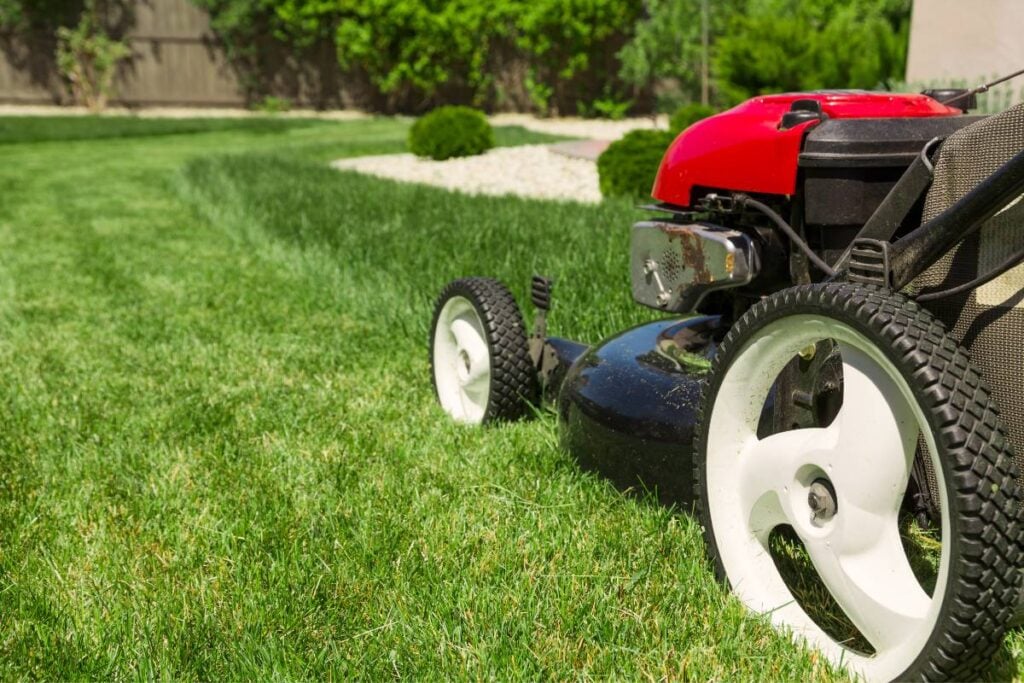
Introduction to lawn mower engine and the role of choke
Lawnmowers are available in various engine types.
The engine inside the mower is a small combustion engine that powers the mower.
Some mowers do not have an engine.
These mowers are called reel lawnmowers.
It used the wheel’s motion to generate the power to turn the blades.
Some mowers run with motors, for example, corded electric motors, battery electric motors, and solar/battery electric motors.
Then comes the traditional lawnmowers powered by engines.
There are two engine types: 2-cycle and 4-cycle engines.
2-cycle engine
The 2-cycle engines are the small engines found in most gas-powered garden tools.
These engines combine the fuel and air in the combustion chamber and ignite with the spark plug.
These engines use a piston’s movement to turn a driveshaft to power the cutting blades and the mower’s drive system.
The piston moves with a small explosion at the cylinder head of the vaporized gasoline. It is called combustion.
These engines consume less fuel than the 4-cycle engines and are cheaper and lighter.
But, these 2-cycle engines don’t produce enough power and are noisy.
4-cycle engine
The 4-cycle engines work the same way as the 2-cycle engines. But their combustion process is divided into 4 cycles:
The piston will move down to draw the fuel and air mixture in the 1st cycle.
The 2nd cycle will move the piston up to compress the mixture.
In the 3rd cycle, the mixture will ignite with a spark plug and explode to drive down the piston. The last cycle will expel the gas from the engine after the piston moves up.
The 4-cycle engines are available with 100cc, like the 2-cycle engines. But they are also available in 1000cc models.
What is the role of the choke?
The choke valve is on the engine’s body or the handle’s lever in an internal combustion engine.
The specific roles of the choke are:
- The choke reduces airflow into the carburetor’s throat and the internal pressure. As a result, more fuel is pushed inside the combustion chamber.
- The choke gives the engine extra air and fuel mixture for combustion. It further helps the mower to keep running efficiently on the open choke.
- The choke valve produces a high partial space to increase the fuel draw.
- The choke valves increase the shelf life and efficiency of the lawn mower.
The engine remains cold when you turn on the mower for a long time.
The choke will open to give your engine extra fuel and enough fuel-air mixture to start the mower and warm it up.
Once the mower is warmed up, the choke turns off, and the mower runs with the fuel received from the tank.
Looking for gardening supplies? We have tested 100's of products before recommending them to you guys. Check out our best pick below:
| Image | Gardening Supplies | Best Price? |
|---|---|---|
 Top
Top Top
Top | Raised Garden Bed Kit | Check On Amazon |
 | XLUX Soil Moisture Meter, Plant Water Monitor, Soil Hygrometer Sensor for Gardening, Farming, Indoor and Outdoor Plants, No Batteries Required | No Results |
 Top
Top Top
Top | 82 Pcs Garden Tools Set and Extra Succulent Tools Set | Check On Amazon |
 | Joeys Garden Expandable Garden Hose with 8 Function Hose Nozzle, Lightweight Anti-Kink Flexible Garden Hoses, Extra Strength Fabric with Double Latex Core, (50 FT, Black) | No Results |
 Top
Top Top
Top | Dual Chamber Compost Tumbler | Check On Amazon |
 Top
Top Top
Top | Sunnyglade Plant Stakes | Check On Amazon |
 Top
Top Top
Top | Organic Cold Pressed Neem Seed Oil | Check On Amazon |
 Top
Top Top
Top | Mighty Mint Gallon :-Insect and Pest Control Peppermint Oil | Check On Amazon |
 Top
Top Top
Top | Scotts DiseaseEx Lawn Fungicide | Check On Amazon |
 Top
Top Top
Top | Jacks Classic 20-20-20 All Purpose Fertilizer | Check On Amazon |
 Top
Top Top
Top | 30,000 Seeds Pollinator Attracting Wildflower Mixture | Check On Amazon |
 Top
Top Top
Top | Survival Vegetable Seeds Garden Kit-Over 16,000 Seeds | Check On Amazon |
Is it wrong to run a lawn mower with the choke on?
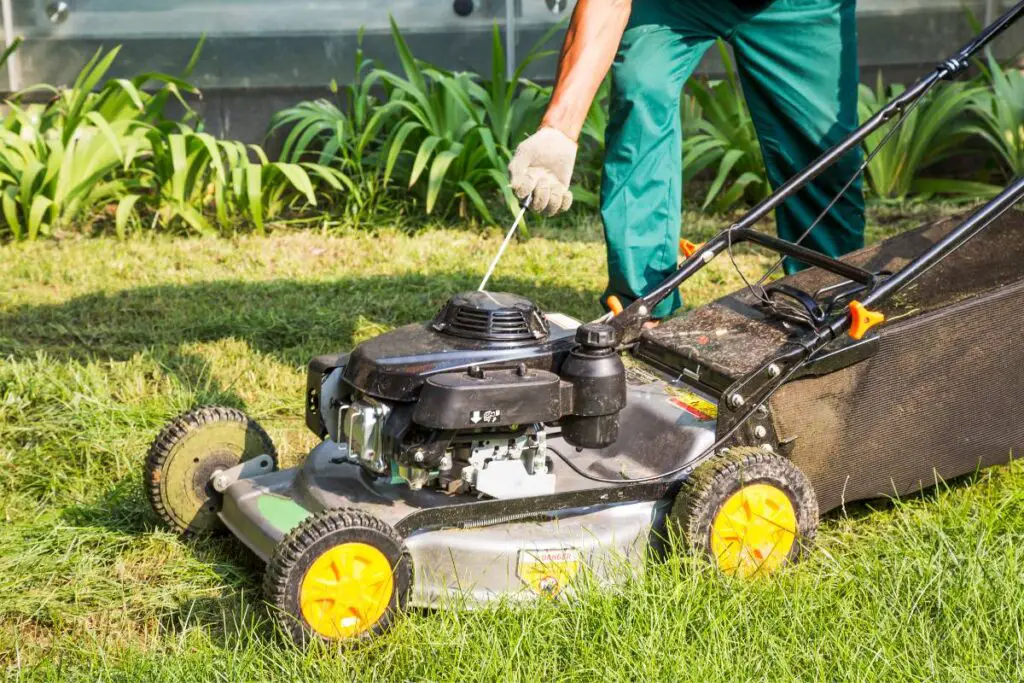
Running the mower on a choke adjusts the fuel-air mixture’s ratio and provides extra fuel for the engine to run efficiently.
But this way, your mower will lose fuel at a faster rate.
When a mower runs only when the choke is on, it has some problems.
Usually, the choke should be in an off position.
The choke helps your mower to warm up when you start the engine after a long break.
Run the mower with an engaged choke for at most 5 minutes.
It is the approximate time for the mower to warm up.
After that, the mower should run with the choke in the off position.
Using the mower with a choke on for more than 5 minutes will increase fuel consumption and wear out the internal components faster.
Even if the mower’s parts don’t wear out, fuel consumption increases.
Lawn mower running only on choke: Causes+Fix
Generally, a lawn mower runs on a choke when you start the mower for a long time to warm up the cold engine.
But if your mower is running well only on a choke and turns off with a choke staying off, that indicates a problem.
There are two circumstances where the lawn mower will only run on choke:
- Your engine has a problem with the fuel-air mixture system
- You are receiving insufficient fuel for your engine
So, what are the reasons behind these two situations? Several reasons are responsible, for example:
- Bad gas
- Dirty carburetor
- Blocked or leaked fuel line
- Blocked fuel and air filters
- Damaged fuel pump
- Bad carburetor gasket and gas cap
Let’s elaborate on all these causes and the solutions in detail.
1. Old gas
A common reason behind a mower not receiving enough fuel is that your engine might be stuffed with old gas.
The gas inside the engine decays after 30 days of purchase.
Ethanol is bad for small engines because it can attract moisture into the fuel system.
Over time, the moisture will evaporate, and the sticky residue will stay behind and clog the internal parts.
The fuel-air mixture also becomes corrosive.
So, the choke valve will open to provide a balanced fuel-air mixture and extra fuel for running.
Solution
Remove the old gas from the mower and replace it with fresh gas. Use unleaded gas containing 87-octane and ethanol within 10%.
If your mower contains gas after a mowing session, empty your tank.
If you don’t want to empty the fuel tank, add fuel additives like Sea Foam SF-16 Motor Treatment – 16 oz., white, or STA-BIL Storage Fuel Stabilizer to clean and reduce the moisture attraction in the fuel system.
The stabilizer will also stabilize the gasoline and increase its shelf life before breaking down.
2. Dirty carburetor
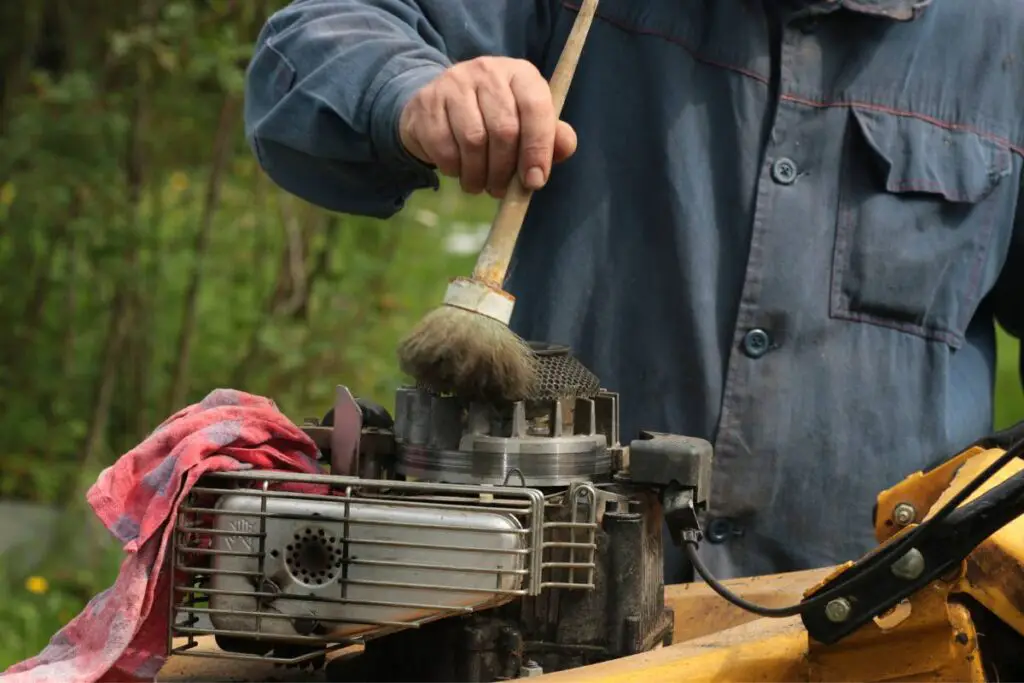
A carburetor is a critical component of the lawn mower. It regulates the gas quantity mixed with the air for combustion.
When it becomes dirty, the fuel passage and the internal parts of the mower clog and fail to operate well.
Due to this, the choke valve will open to push out extra fuel the mower needs to keep running.
It would be best to clean the carburetor.
Solution: How to clean a carburetor?
Cleaning the carburetor will be easier if you have done mechanical work before. But if not, take your mower to an expert.
There are two ways to clean the carburetor:
- You can spray the carburetor without removing it from the mower
- You have to clean the carburetor thoroughly by dismantling it from the mower
I always prefer the spraying method.
I regularly check my mower and spray the carb 1-2 times yearly whenever I see it dirty.
Spraying the carburetor
If you don’t want to remove the carburetor, locate it and spray some cleaner on it.
Remove the air filter from your mower, and spray some carb cleaner or carb aerosol into the air intake.
After the spray dries, turn your engine back to see the choke’s condition.
If the choke is off, you have successfully cleaned the carburetor.
Otherwise, it needs a thorough cleaning.
I prefer using Gumout 8000002231 Carb and Choke Cleaner, 14 oz for a cleaner. (Pack of 6) for my Riding mower.
Thorough cleaning
Once, my riding mower’s carburetor was so dirty that I needed an expert suggestion.
I was a newbie then with mowers and all the maintenance they required.
Thankfully, one of my cousins helped me out as he had experience in thorough carb cleaning.
I followed him attentively and tried doing it once. Fortunately, I succeeded.
In this section, I will share the steps I followed for thorough cleaning.
First, gathering ideal tools is crucial to speed up the cleaning. Here are the tools you need:
- Screwdrivers
- Pliers
- Sockets
- Ratchets
- Wrench
Now, the steps:
- Remove the spark plug, the throttle, and the choke cables.
- Remove the filter housing and unscrew the nuts that hold the carburetor.
- Twist the carb and open the springs to prevent the carburetor from stretching.
- Carefully see the gasket to ensure you don’t tear them.
- Now, unscrew the bottom screw at the float bowl to detach it without hurting the O-ring.
- Examine the stem hanging from the carburetor’s center for clogged holes.
- Use a thick wire to clean the clogging with a flashlight and spray it with some carb cleaner.
- Next, check for white buildup in the carburetor. These white crusts are the leftovers of fuel additives and ethanol.
- Clean this buildup with some carb cleaner.
- If you have taken the carburetor out, sink it in a container filled with coke and carburetor cleaner.
- After some time, take it out, clean it again a bit, let it dry, and put it back as it was into the mower.
- Add fresh fuel to the engine with some fuel stabilizer to avoid gas breakdown.
- Start the mower with the choke off to see if it is running well.
3. Puncture or blockage in the fuel line
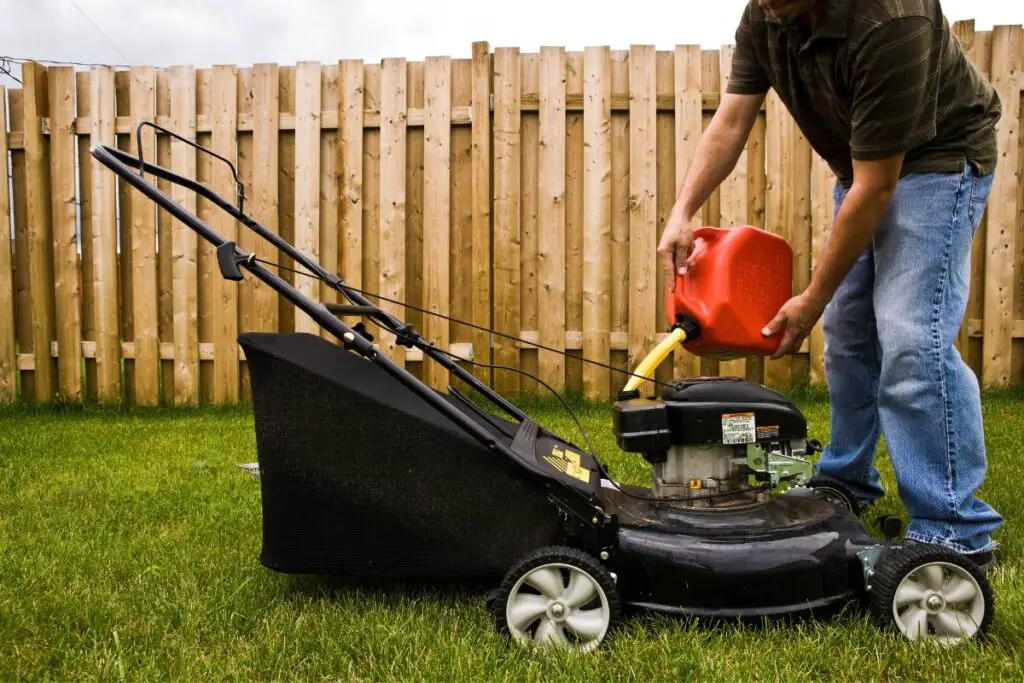
A leakage in the fuel line will make the air get sucked into the line. As a result, the engine receives excessive airflow.
Blockage in the fuel line means your engine receives insufficient fuel.
When the choke is on, it will reduce the engine’s airflow and give you enough fuel and fuel-air mixture to work efficiently.
Solution:
Check the fuel lines closely to watch for signs of clogging or leak.
Follow the line from the fuel line up to the carburetor.
Check for holes, cracks, or any leakage responsible for increasing the airflow into the fuel system.
If there is no leakage, check for clogging in the fuel line.
Shut off the fuel power with the fuel shut-off valve, remove the end part of the fuel line, and put it in the container to collect the fuel.
Turn the flow back on and check for smooth fuel flow into the container.
If you don’t receive enough flow, you have a clogged line.
Remove the fuel line from your lawn mower, spray some carburetor cleaner into the line, and wait some time to loosen the clogging.
Next, provide some compressed air to remove the clogging.
Repeat if needed.
If the fuel line is badly clogged, you may have to replace it. Please take it to an expert for replacement.
4. Clogged air filter
The lower engine will need air for the fuel-air mixture.
The air filter filters the air to trap the dirt particles.
But the filter will become excessively dirty over time and block the air.
A dirty filter will interrupt the air and fuel mixture and stop your mower from working correctly.
The choke will open to correct the fuel-air ratio.
Change the filters every 3 to 4 months.
Solution:
Two types of air filters are available for lawnmowers – paper filters and foam filters.
I prefer changing the air filters every 3 months, and below, I will share the steps I follow to change both types of filters.
For paper air filters:
- Unscrew the clips, knobs, or wing nuts and remove the filter from the air filter housing.
- Take out the filter and remove the dirt from it. Ensure not to let dirt and debris fall into the air intake.
- Tap your fingers against the solid surface to dislodge as much dirt as possible.
- Hold the filter up to the light and see if you can see anything through it.
- If you can see through it, your filter is clean, and you can put it back into the mower.
- If the filter is too dark, install a new one and reattach it to the filter housing.
For foam filters:
- Remove the filter from the housing and the leftover dirt from it.
- Ensure no dirt falls into the air intake.
- Examine the filter closely and see signs of brittle, tear, or damage.
- If there is, you have to replace the filter. If not, you can go on with it with some cleaning.
- Wash it with a bit of mild detergent or soap water. Rewash it with clean water until the soapy water is removed.
- Let the filter dry out for some time.
- Coat the filter will filter oil. You should saturate the filter lightly and not soak it.
- Reinstall the filter into the housing and check your mower’s functionality by turning off the choke.
5. Clogged fuel filter
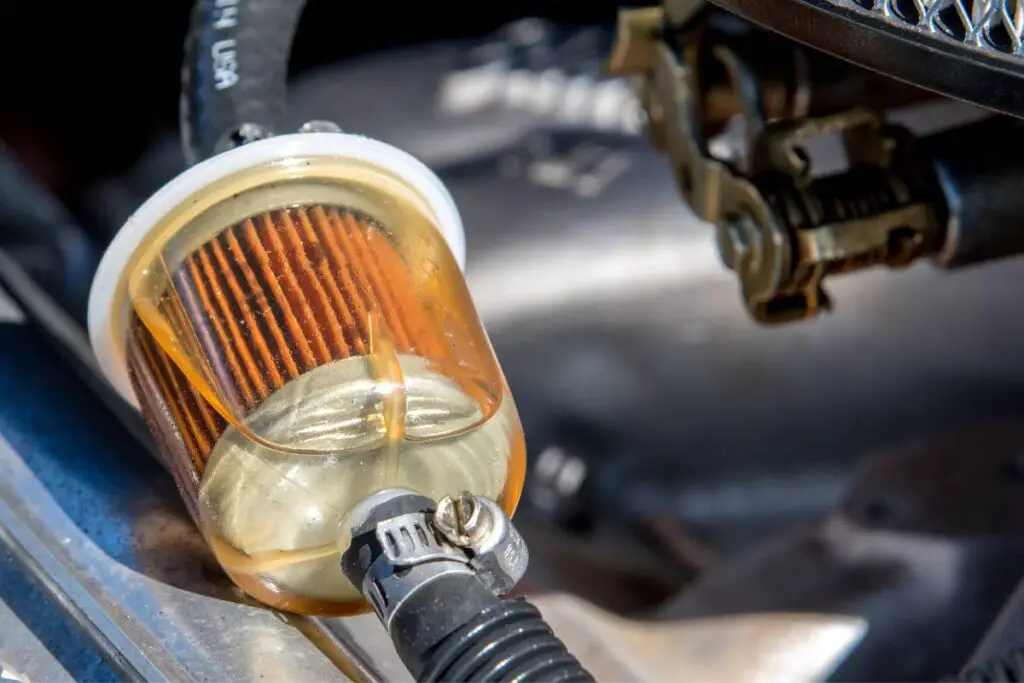
The fuel filter is located between the fuel lines that filter the fuel system by trapping the dirt and debris and preventing the mower from a faster wear-out.
Over time, the filter will trap a lot of dirt particles and reach a time when they won’t be able to pass the fuel into the fuel system.
As a result, the engine will receive less fuel and won’t start working.
So, the choke valve will open to correct the fuel-air ratio and give your engine enough fuel to work efficiently.
Solution:
- Shut off the fuel supply by turning off the valve on the mower, remove the clogged filter from the mower, and insert a new inline fuel filter between the fuel lines.
- If the mower doesn’t have a valve, use pinch pliers to crimp the fuel line and stop the flow.
- While installing, you will see an arrow on the filter housing side.
- The filter you install must be inserted to position the arrow toward the fuel flow.
I recommend changing these filters annually. It can save your mower from several other issues besides this problem.
6. Faulty fuel pump
The fuel pump in the lawn mower is used when the carburetor is higher than the fuel tank.
The pump used the vacuum off the engine to move the fuel from the tank to the carburetor.
Check the pump to see if it is working well.
Solution:
First, confirm whether the pump receives enough fuel into the inlet port.
Then, remove the fuel line from the carburetor and keep it in the container to collect the fuel.
If the fuel flow is insufficient, replace the pump. Consult an expert for the replacement.
7. Bad carburetor gasket
The gasket is located behind the mower carburetor. It can wear out and degrade over time.
So, it will no longer seal and allow extra air to enter into the fuel system and cause the engine to run poorly.
A mower will run lean when the air concentration is higher than the fuel in the fuel-air mixture.
The choke will then open to reduce airflow and maintain the air and fuel mixture ratio.
Solution:
Check the carburetor to ensure the bolts are secured tightly and the gasket is not loose.
If the gasket is not sealing correctly, go to the carburetor and remove the linkages and bolts attaching the carburetor.
Remove the carburetor and the gasket and replace the gasket with a new one.
Now, reattach the carburetor, the bolts, and the linkages.
8. Bad gas cap
The fuel tank should vent to let air enter the tank.
A vacuum will develop in the fuel tank if the vent is clogged and the air fails to enter the fuel tank.
It will further not allow the fuel to reach the carburetor.
The mower’s fuel tank vent out of the gas cap. Use a pressure gauge to check if there is a vacuum buildup.
Or, check the vacuum buildup with the following steps:
- Loosen the gas cap to let air enter the tank.
- Place the choke in the off position.
- If the engine continues with an unengaged choke.
- Do the same thing by tightening the cap again with the choke off.
- If the engine sputters, dies, or works with the choke on, you have a bad gas cap.
Solution:
Buy a new gas cap and replace it with the old one. If you cannot do it, consult an expert.
Preventive measures and maintenance tips to avoid further issues with your lawn mower
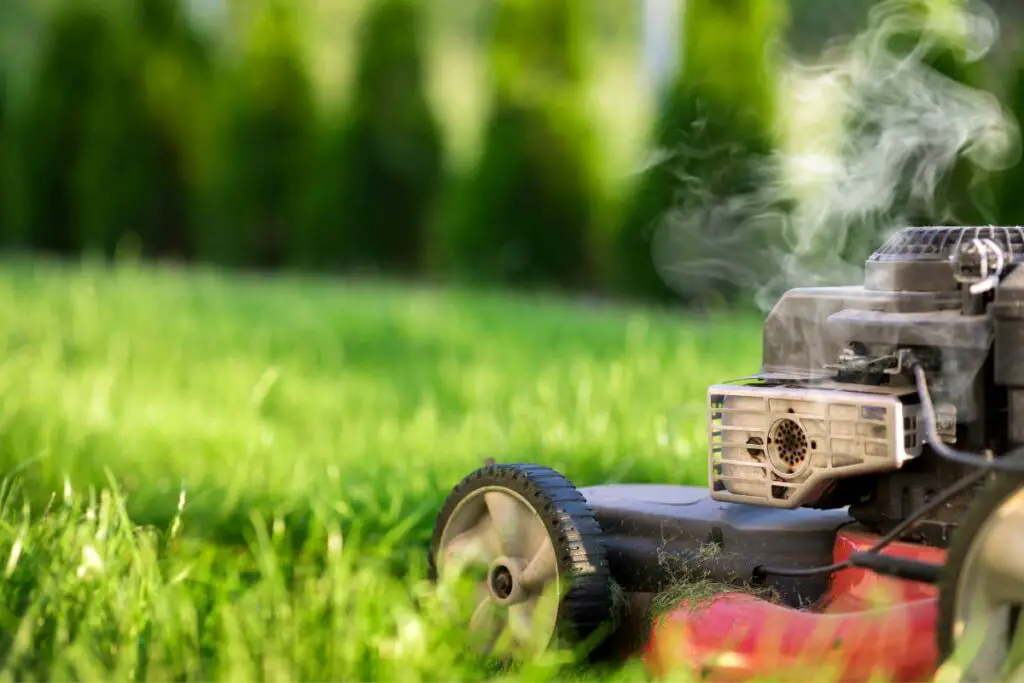
Fixture a mower that runs on choke is a simple task for the experts.
But it can be difficult for the first few times if you are doing it.
Once you get acquainted with it, fixing it will be easy.
The important thing is to prevent the problem from further occurrence by adequately maintaining the mower.
Here are some maintenance tips to prevent the mower from further issues:
- Avoid keeping old gas in the mower for a long time. If you keep it, add some fuel stabilizers to keep it safe.
- Avoid using ethanol-based gasoline.
- Clean or replace the air filters every 3-4 months. Replace the fuel filters annually.
- Clean your carburetors annually with carb cleaners. By this, you don’t have to do a thorough cleanup.
- Check the fuel lines and pumps to know their condition and see if they need any change.
- Prefer annual maintenance of the whole mower – the engines, the filters, the carburetors, the gaskets, gas caps, and other internal components.
- Also, regularly clean and sharpen the mower blades to prevent other issues.
- If in doubt, take your mower to an expert.
Final Thoughts
Fixing a mower that runs on a choke is difficult if you know the possible causes and how to solve them. The reason behind a mower running only on choke is old gas, clogged fuel filters and air filters, blocked or punctured fuel lines, clogged, dirty carburetors, bas carburetor gasket and gas caps, and old gas.
To troubleshoot these problems, clean out the dirt buildup in the internal components, replace the punctured or damaged fuel lines and pumps, and avoid keeping old gas in the engine. If you keep old gas, add some fuel stabilizer.
Follow the preventive measures I shared to avoid the problem from further occurring. If you invest enough money in a mower, maintain it well to increase its lifespan and make the most of it. With regular care and maintenance, you can enjoy using a fully functional mower and enjoy an attractive lawn.
Why do small engines have a choke?
The choke valves help the tiny droplets of gasoline to evaporate and start the mower faster when the engine is cold.
What happens if you leave a choke on in the mower overnight?
Letting the choke on in the mower for too long leads to faster fuel consumption and wear out.
Reference: Lawn Mower Wikipedia

